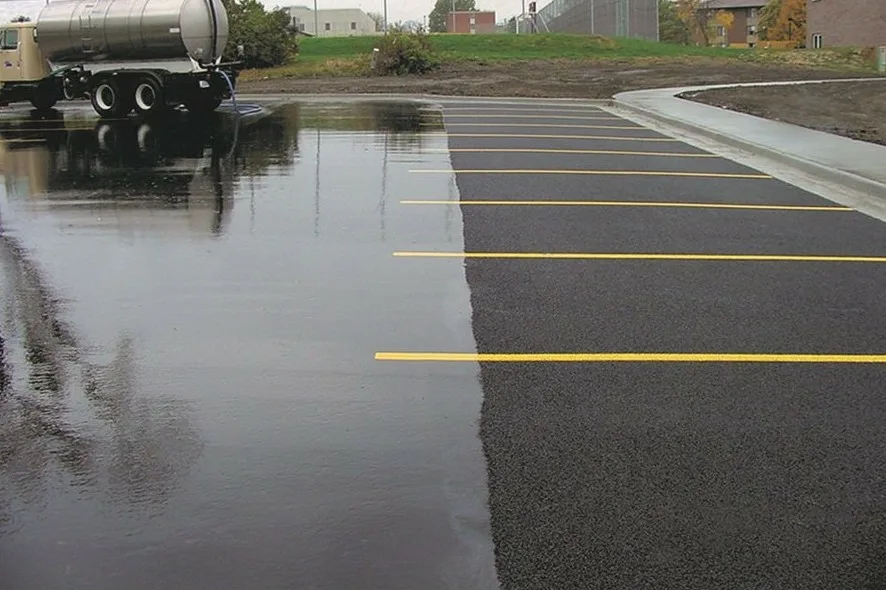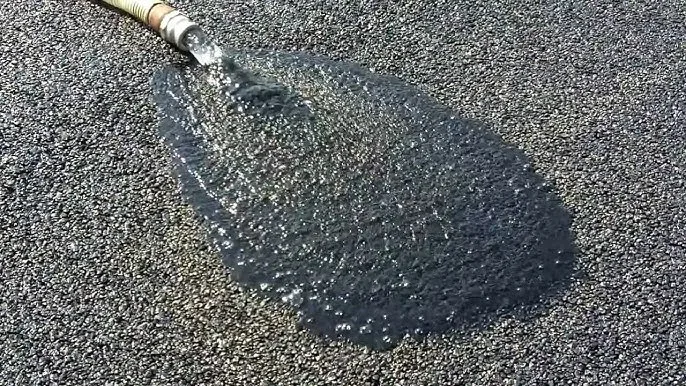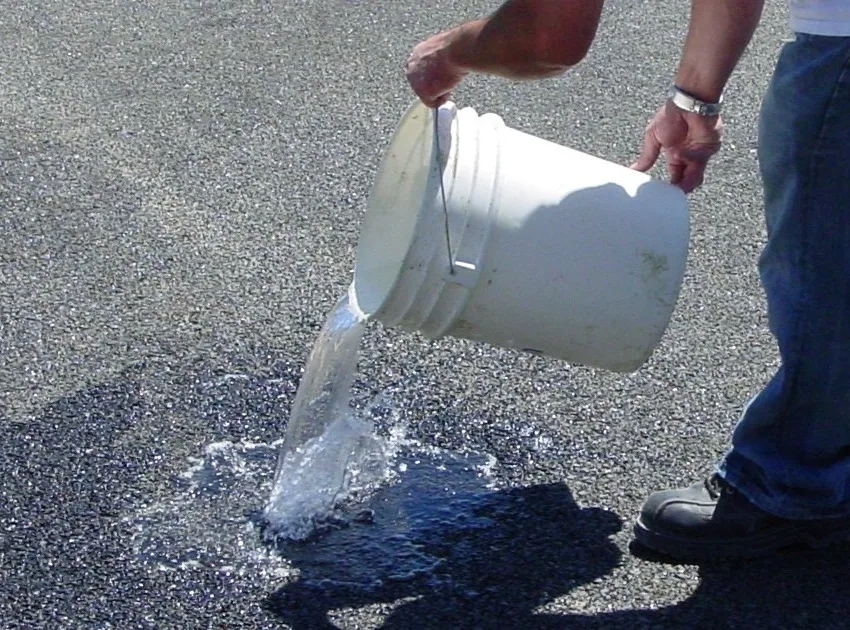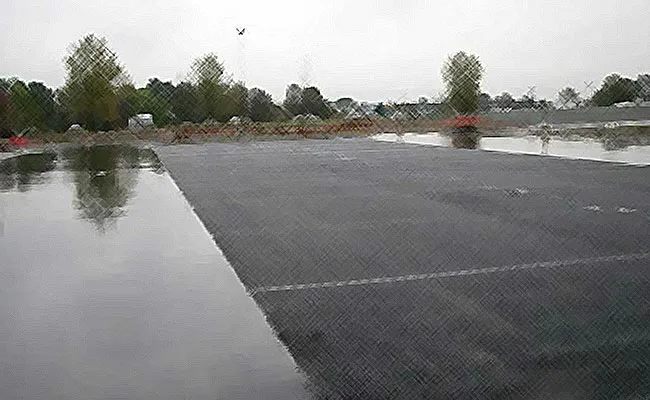Porous asphalt pavement is a specialized type of pavement composed of coarse aggregates, asphalt binder, fine aggregates and sediments , that allows water to pass through its surface. The pavement includes a durable asphalt layer over a base of uniformly graded stone, which temporarily holds water before it infiltrates into the ground. The absence of fine particles enhances permeability while maintaining strength for load-bearing use. This design enables efficient water movement through the pavement, reducing surface runoff and supporting natural drainage.
Layers of Porous Asphalt Pavement
Porous asphalt pavement consists of several key layers that work together to facilitate water infiltration and structural stability:
- Surface Course – The top layer that is made of porous asphalt with coarse aggregates and minimal fines, allowing water to pass through.
- Filter Layer (Optional) – A layer of geotextile or finely graded aggregate to prevent clogging and separate materials.
- Reservoir Course – A thick layer of uniformly graded, crushed stone that temporarily stores water and provides structural support.
- Subgrade – The compacted natural soil layer that supports the pavement system and allows water to infiltrate into the ground.
Advantages of Porous Asphalt Pavement
- Allows water to infiltrate, reducing surface runoff.
- Helps prevent water accumulation and urban flooding.
- Facilitates natural water percolation, replenishing aquifers.
- Decreases reliance on traditional drainage systems.
- Filters pollutants and contaminants before reaching groundwater.
- Lowers surface temperatures compared to traditional pavements.
- Minimizes soil displacement by controlling runoff flow.
- Requires less repair compared to conventional asphalt or concrete.
- Reduces surface water, minimizing hydroplaning and skid risks.
- Can incorporate recycled materials, reducing environmental impact.

Methods for Laying Porous Asphalt Pavement
- Conventional Paving Method- This method follows standard asphalt paving techniques with modifications to accommodate the porous mix. The asphalt is laid uniformly to prevent segregation of aggregates, ensuring even permeability. Controlled compaction is applied to maintain void spaces while achieving the necessary strength.
- Layered Construction Method- In this approach, the pavement is built in multiple layers, each serving a specific function. The surface layer consists of porous asphalt, followed by a filter layer that prevents clogging, and a reservoir course that temporarily stores water before infiltration. This method enhances durability and improves water management.
- Full-Depth Placement- This method involves constructing the entire pavement system using permeable materials, eliminating impermeable barriers. The porous asphalt is placed directly over a thick crushed stone base, allowing water to infiltrate through all layers. It is particularly useful in areas requiring maximum water infiltration, such as eco-sensitive or flood-prone zones.
- Compacted Base Method- The focus of this method is on preparing a stable yet permeable base layer. A uniformly graded stone base is compacted to provide structural strength while maintaining void spaces for water infiltration. Over-compaction is avoided to ensure the base remains functional for drainage.
- Geotextile Separation Method- In this method, a geotextile fabric is placed between the subgrade and the stone base to prevent fine soil particles from clogging the drainage system. This method is particularly beneficial for sites with weak or unstable subgrades, as it helps in maintaining stability and long-term permeability.
- Rolling with Compaction Control- Controlled rolling method is used to balance strength and permeability in porous asphalt pavement. Compaction is carefully adjusted to avoid excessive pressure that could crush aggregates and reduce void spaces. The number of rolling passes is determined based on the asphalt mix design and site conditions to achieve optimal structural integrity and water infiltration.

Equipments Used for Laying Porous Asphalt Pavement
- Asphalt Paver
An asphalt paver spreads the porous asphalt mix evenly across the base, ensuring uniform thickness and proper surface texture. It consists of a conveyor system that moves the asphalt forward and a screed that levels and compacts it. The paver must operate at a steady pace to prevent material segregation, which could affect permeability. Proper control of the paving speed and temperature is essential to ensure the mix remains workable and retains its intended drainage properties. - Drum Roller/Static Roller
A drum roller or static roller is used to compact the asphalt layer without excessive pressure, preserving the necessary air voids for water infiltration. Unlike vibratory rollers, it applies steady weight to achieve the required density while maintaining drainage capacity. Controlled passes ensure proper compaction without overloading the material. This type of roller is particularly effective in preventing aggregate crushing, which could reduce the long-term effectiveness of the porous pavement. - Vibratory Roller
This roller is used to compact the base layer before the porous asphalt is applied. It combines weight and vibration to settle the stone aggregate, creating a strong foundation. However, it is not used on the asphalt surface itself, as excessive compaction could close the void spaces required for water infiltration. The vibration mechanism helps achieve uniform compaction, preventing weak spots that could lead to structural failure or uneven settlement over time. - Cold Milling Machine
When replacing or overlaying old pavement, a cold milling machine grinds and removes the top layer of existing asphalt. This ensures a proper surface for bonding the new porous layer while maintaining the correct elevation and drainage slope. By removing deteriorated material, the milling process helps create a uniform substrate, preventing defects in the new pavement and allowing for better water infiltration through the porous asphalt. - Excavators
Excavators are used for site preparation, including soil excavation, debris removal, and trenching for drainage systems. They also help place large amounts of crushed stone for the reservoir layer, ensuring a stable foundation for the pavement. Their ability to handle large volumes of material efficiently makes them essential for shaping the subgrade and ensuring proper depth and stability before paving begins. - Graders
Motor graders level and smooth the subgrade and base layers, ensuring proper slopes for drainage. They help distribute aggregate evenly before compaction, preventing uneven settlement and maintaining the permeability of the pavement. Proper grading ensures that stormwater is efficiently directed into the porous system, preventing surface pooling and enhancing long-term pavement performance. - Front-End Loaders
These machines handle bulk materials, such as loading asphalt into pavers and transporting stone for the base layer. Their ability to move heavy loads efficiently helps maintain a steady supply of materials throughout the project. Front-end loaders are also used to mix and distribute aggregate evenly, ensuring consistency in the pavement layers, which is important for maintaining the desired permeability. - Bulldozers
Bulldozers are used to clear and level the construction site before paving begins. They push and spread materials like soil and aggregate, shaping the base to ensure proper drainage and stability. Their powerful blades allow for efficient movement of large amounts of material, making them useful in site preparation, especially in projects where extensive grading and land reshaping are required.

Porous Asphalt Pavement applications
- Roadways and Highways – Used in areas with heavy rainfall to reduce surface water accumulation and improve skid resistance.
- Parking Lots – Helps manage stormwater on commercial, residential, and institutional properties, reducing the need for additional drainage infrastructure.
- Sidewalks and Pathways – Enhances pedestrian safety by minimizing water pooling and reducing ice formation in colder climates.
- Driveways – Provides homeowners with a durable and environmentally friendly alternative for managing rainwater infiltration.
- Bicycle Lanes and Trails – Reduces surface water accumulation, improving traction and safety for cyclists.
- Airport Runways and Taxiways – Used in select areas to enhance drainage and minimize hydroplaning risks.
- Industrial and Commercial Sites – Manages runoff efficiently, reducing the load on stormwater drainage systems in large facilities.
Conclusion
Porous asphalt pavement improves drainage, reduces runoff, and offers lasting durability. Its versatility makes it a reliable, sustainable solution for various applications, enhancing both infrastructure and environmental benefits.


